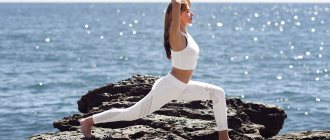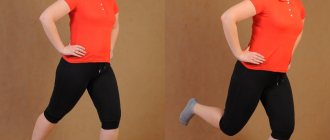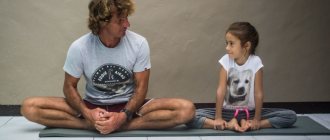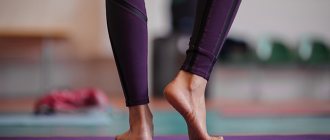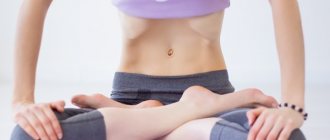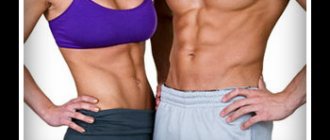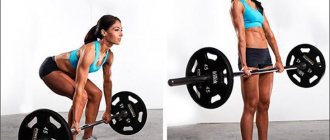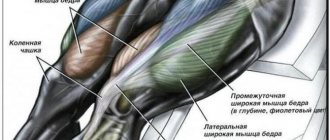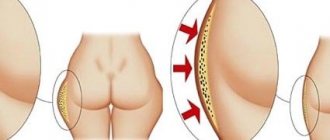Hamstring stretch[edit | edit code]
Hamstring stretch - medium difficulty.
Execution[edit | edit code]
Hamstring stretch
- Initial position. Lie on your back, then lift your head and shoulder blades off the mat, as if doing a crunch. Lift one straight leg up and clasp it with your palms at the ankle. Raise your other leg slightly so that your lower back maintains firm contact with the mat. Both legs are fully straightened at the knees, toes slightly pointed out.
- Exhalation. Pull your stomach in a little more and pull your upper leg towards your forehead with your hands in two successive movements that occur simultaneously with two active exhalation impulses.
- Inhale. Without bending your knees, change their position and move your hands to the other leg.
- Exhalation. Bring your other leg toward your forehead, maintaining the same breathing pattern as in the previous movement. Repeat the hamstring stretch 10 times (5 times with each leg), alternating the position of your legs as you inhale and stretching the muscles as you exhale, then return to the starting position.
Stretching the muscles of the front of the thigh: general rules
Any stretching of the rear and anterior muscles requires compliance with the rules, first of all, so as not to damage your health, and secondly, so that the achieved result is maintained for a long time.
Muscle stretching
Classes are conducted systematically. The number of classes should not decrease.
You will need to learn how to properly relax your leg muscles, otherwise you may end up with chronic fatigue syndrome.
Before stretching the thigh muscles, it is recommended to warm up, otherwise you may end up with an injury. Exercises that are often suggested as stretching include rotation of the pelvis and ankle joint of the legs.
Consider going for a run as a great way to exercise. You need to run at a normal pace, jumping from foot to foot with swinging movements. You can warm up by jumping in place, on one leg or both.
Warming up the leg muscles before stretching will prepare the ligaments for the exercise.
The minimum time spent in a stretching pose is 10 seconds, gradually increase to 60. Stretching for less time will not give results.
To achieve success when stretching, you need to breathe deeply. You can't hold your breath!
Remember, muscle stretching is not supposed to be painful. Some discomfort is acceptable, especially in the initial stages, but not pain.
To harmoniously stretch your thigh muscles, it is recommended to create a muscle stretching program.
Good muscle stretching is the result of many years of work on the body. You will need to have a considerable amount of patience to engage in this type of activity.
The benefits of exercise are obvious: the effects of stress are prevented, weight is normalized, the cardiovascular system begins to function normally, and the body’s overall resistance is developed.
Training is gradually becoming a part of life. Stimulate your own interest by doing family or group activities.
Main working muscles[edit | edit code]
Muscles that flex the spine
: rectus abdominis, external oblique, internal oblique.
Muscles that flex the leg at the hip joint
: iliopsoas muscle, rectus femoris muscle, tensor fascia lata, pectineus muscle.
Accessory muscles[edit | edit code]
Abdominal muscles that stabilize the spine
: transverse abdominis muscle.
Muscles that extend the leg at the hip joint
: gluteus maximus, posterior thigh muscle group.
Muscles that extend the leg at the knee joint
: quadriceps femoris muscle.
Muscles that perform plantar flexion of the foot at the ankle joint
: gastrocnemius muscle, soleus muscle.
Muscles that flex the arm at the shoulder joint
: anterior bundle of the deltoid muscle, pectoralis major muscle (clavicular bundle).
How to properly stretch your thigh muscles
A flexible, elastic body is a person’s dream. It is possible to try to achieve your plans. The right set of exercises performed daily will help you achieve your cherished goal.
The front surface of the thigh is a delicate part; you need to stretch it carefully. The area is pumped at an accelerated pace, becomes very noticeable, “swollen”, to prevent this, you will need to give up excessive weights when working with the front surface of the thigh. The muscles of the legs are pumped much less often than other parts of the body.
Recommendations for execution technique[edit | edit code]
- In Phase 1 of the hamstring stretch, draw your stomach in strongly and contract your abdominal muscles isometrically to keep your upper torso suspended, maintain a stable pelvis, and keep your lower back and sacrum firmly in contact with the mat throughout the exercise and especially as you change leg positions.
- Keeping your core stable, fully straighten both legs. They should form straight lines due to the work of the muscles that extend the leg at the knee joint and perform plantar flexion of the foot at the ankle joint.
- At the beginning of Phase 3 of the hamstring stretch, as you change leg positions, use your hip flexors to lift your lower leg and your hip extensors to lower your upper leg. When the top leg goes beyond the vertical line, the hip flexors must prevent it from falling due to gravity.
- In Phase 4, focus on keeping your bottom leg at a constant height off the mat while your top leg is pulled toward your head. This movement dynamically stretches the hamstrings. The upper leg is pulled up by the muscles that flex the arm at the shoulder joint. At the same time, the elbows are spread to the sides.
- Try to maintain a neutral position of your shoulder blades, without spreading them out to the sides or lifting them.
- Mental image. Imagine your legs moving like scissors. The movement should only occur at the hip joint.
Piriformis muscle - stretching
The piriformis muscle can be very troublesome and cause sciatica symptoms, including leg pain. Training this muscle, especially in combination with other exercises, will maintain its elasticity and prevent damage to the sciatic nerve.
- Lie with your shoulder blades on the floor.
- Bend your right leg and cross the ankle of your left leg over your right leg.
- Cross your leg over your upper thigh.
- Pull your leg as close to you as possible to increase the pressure.
- The exercise time is 10-30 seconds.
Muscles involved: Piriformis.
Try doing the same as shown in the video below:
Notes[edit | edit code]
Hamstring Stretch
The hamstring stretch is very similar to the single leg stretch. The only difference is that in this case both legs are straightened. By pulling your extended upper leg towards your chest, you dynamically stretch the hamstring muscle group, which is often tight. When lowering your leg, you have to tighten your abdominal muscles more to maintain a stable position of the pelvis and lumbar spine.
Modifications[edit | edit code]
If the hamstring muscles are very tight, you can place your hands closer to the thigh or slightly bend your knee, pulling it towards your head.
Option[edit | edit code]
The hamstring stretch can also be performed with your bottom leg on a mat. This limits the posterior tilt of the pelvis and provides better stretching of the posterior thigh muscles.
Contraindications to stretching the thigh muscles
Before practicing stretching, you need to make sure that there are no problems with your back, neck, legs and other parts of the body.
Stretching is contraindicated for the following diseases:
- arthrosis;
- osteoporosis;
- hematomas;
- thrombosis;
- hypertension;
- hernias;
- malignant tumors.
People who have had surgeries, injuries, or leg fractures should not engage in this type of fitness.
Before planning training, you should consult with your doctor and rule out possible pathologies.
It is important to follow the general rules for performing stretching exercises, do it regularly and have fun.
Stretching is necessary for absolutely everyone: those who are used to a sedentary lifestyle, those who play sports only on weekends, and those who actively exercise daily. Stretching not only improves blood flow to muscles and allows joints to move through a full range of motion, but also improves posture, enhances athletic performance, and reduces the risk of injury. This article provides stretches for the lower back, pelvis, groin, and hamstrings.
Our flexibility is freedom of movement. Stretching specifically tailored to specific parts of our body will significantly improve your flexibility. Stretching is even more important than exercise. The advantage of such stretching exercises is that they do not require any investment in special equipment and are great for doing at home.
Stretching while lying down
There are also many gymnastics complexes for stretching in a lying position. To stretch while lying down, lie on one side, bend your knee, and pull your heel as close to you as possible. The other leg can be left straight.
The foot should reach towards the buttocks, but you should not be overzealous so as not to injure the ligaments. You shouldn't move your pelvis. It is better to try to keep it in place by pressing it to the floor. After completing the movement, the foot can be slowly returned to its place, after which the exercise can be continued on the other leg.
Thanks to this complex, not only the front surface of the thigh will be stretched, but also the lumbar and gluteal regions.
Lunge Stretch
Another version of hip exercises is the lunge. To do this, lunge on one leg, bending the other at a right angle and placing it so that the knee does not go beyond the toe.
Next, move your pelvis forward to feel the stretching of the muscles. The heel should not be lifted off the floor.
During this exercise, not only the front part, but also the gluteal region works well. If you perform the exercise at the same interval and the same degree of load on both legs, you can eliminate the appearance of asymmetry. It has long been known that asymmetrically developed and stretched legs will lead to the appearance of scoliosis in humans.
Also a good complex would be exercises from the famous Suzanne Bowen. She suggests doing the lunge this way. Having transferred the weight of your own body to one leg, you need to feel a slight tingling sensation in the opposite thigh. If you place one leg behind you, stretching it across the floor, and bring the other one forward as much as possible, then stretching will be more effective. But this exercise option will not be available for people who have severely stiff areas of the anterior thigh and buttocks.
The back should remain straight, the torso should be kept strictly symmetrical, without leaning forward, backward or to the sides. You can breathe every five counts, replacing the position of your body with each exhalation.
Stretching while standing on one leg
Stretching the front of the thigh can be done in different ways. The classic version involves the position of the person’s body standing on two legs, while stretching in different directions, similar to how one would want to sit on the cross splits.
If you perform stretching on one leg, the rectus muscle will be stretched most strongly and effectively. It should be taken into account that it will be necessary to maintain balance. To do this, you can either stand at a support or control your movements.
Bend one leg at the knee and take it back, holding it with your hand from behind. At the same time, the second leg, which is located on the floor, should remain level and straight. The knee should not be bent. You will feel a stretch in your thigh muscles, including your glutes.
